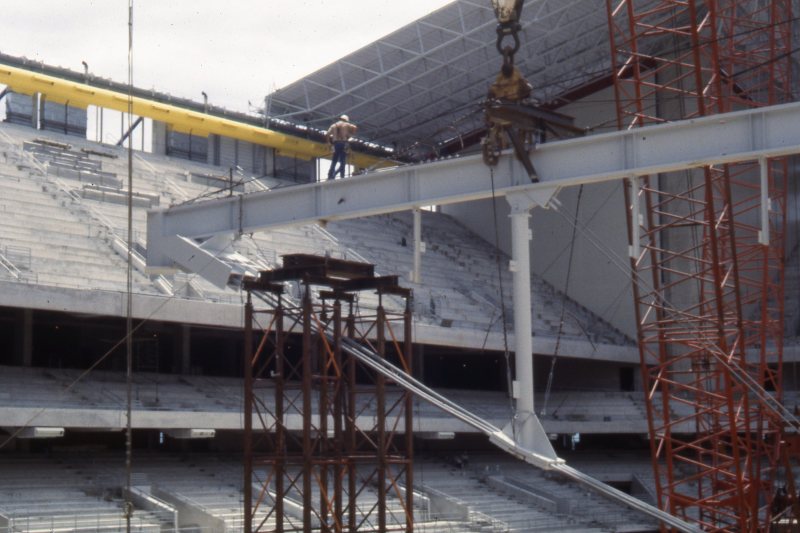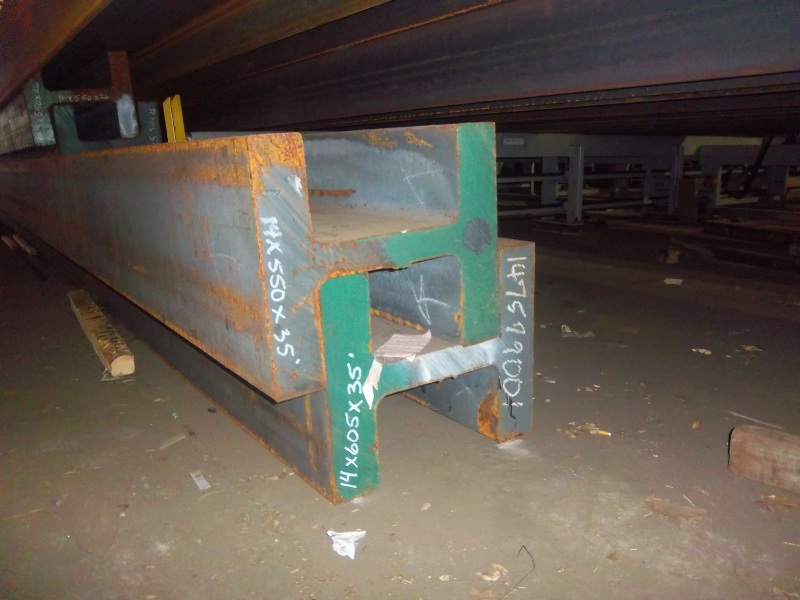Navigation
Install the app
How to install the app on iOS
Follow along with the video below to see how to install our site as a web app on your home screen.
Note: This feature may not be available in some browsers.
More options
Style variation
-
Congratulations cowski on being selected by the Eng-Tips community for having the most helpful posts in the forums last week. Way to Go!
You are using an out of date browser. It may not display this or other websites correctly.
You should upgrade or use an alternative browser.
You should upgrade or use an alternative browser.
Anyone ever use these W14s and what did you use them for? 4
- Thread starter dlclarkii
- Start date
- Status
- Not open for further replies.
Not quite that big, but have done W14s in the 300-400 lb/ft range for chord members of long span transfer trusses.
Edit: Actually remember another job that had a W14x500, both as a chord of a transfer truss and then for some of the columns supporting the transfer.
Edit: Actually remember another job that had a W14x500, both as a chord of a transfer truss and then for some of the columns supporting the transfer.
SlideRuleEra
Structural
Columns to support the boiler at electrical generating stations. The boiler hangs from the top of the structural steel so that thermal expansion causes it to "grow" downward (several inches) at normal operating temperatures. Since the boiler structure may be 250 feet high, or so, these columns have to support astounding loads.
![[idea] [idea] [idea]](/data/assets/smilies/idea.gif)
![[r2d2] [r2d2] [r2d2]](/data/assets/smilies/r2d2.gif)
![[idea] [idea] [idea]](/data/assets/smilies/idea.gif)
![[r2d2] [r2d2] [r2d2]](/data/assets/smilies/r2d2.gif)
-
2
- #4
Largest I've ever used was a W36x720.
Top chord of a 378 ft. long bowstring truss which used three, 4 inch diameter bridge strand for the bottom chord.
The flanges were 3.9 inches thick with a 2.165 inch web. Got them from Belgium I believe.

Check out Eng-Tips Forum's Policies here:
faq731-376
Top chord of a 378 ft. long bowstring truss which used three, 4 inch diameter bridge strand for the bottom chord.
The flanges were 3.9 inches thick with a 2.165 inch web. Got them from Belgium I believe.

Check out Eng-Tips Forum's Policies here:
faq731-376
-
1
- #6
- Thread starter
- #8
I saw an interesting one at a power plant in New Mexico 40 years ago where A W14x320 (or thereabouts) was used as a core section and then had approximately 20 x 3" cover plates welded to both flanges. As noted above, this was the supporting steel for the boiler structure.
JoshPlumSE
Structural
I've seen them used as columns, though not on any job that I've worked on.
If you look at the AISC manual you will see that W14's come in a wide range of sizes, from x22 all the way up to x730. No other shape has nearly that wide a range of profiles. This was clearly done* for use as columns in high rise buildings, as Hokie66 pointed out.
Dlclarkii, were those salvaged from the World Trade Center buildings, per chance? I find it unlikely that a fabricator would "just so happen" to have such sizes lying around. In preparation for a new job or left over from an old job gone bust, yes, but not as part of his general inventory unless he's intent on going out of business.
*EDIT: perhaps a better way to have worded this would have been: It seems to me that this was likely done to meet the requirements of high rise buildings and other structures that require members capable of taking extremely large compression members. W14 lends itself to being able to be rolled to a very large cross sectional area while keeping ry as large as possible. It is an "efficient" shape in that regard.
Dlclarkii, were those salvaged from the World Trade Center buildings, per chance? I find it unlikely that a fabricator would "just so happen" to have such sizes lying around. In preparation for a new job or left over from an old job gone bust, yes, but not as part of his general inventory unless he's intent on going out of business.
*EDIT: perhaps a better way to have worded this would have been: It seems to me that this was likely done to meet the requirements of high rise buildings and other structures that require members capable of taking extremely large compression members. W14 lends itself to being able to be rolled to a very large cross sectional area while keeping ry as large as possible. It is an "efficient" shape in that regard.
- Thread starter
- #13
To my knowledge, they're drops, left over pieces from a previous order. A customer ordered a specific length but didn't want the drop. So the supplier has these large beams stored incase someone else may need a W14 of this size.
edit: Which is stupid, when you buy a beam you're paying for the stock length, not just the length you want. So someone paid for these full length pieces plus cutting charges but didn't want the drop. At 60¢/lb that's $300/ft x 35' is a $12,000 beam! Granted I probably wouldn't want these drops if I were a fabricator and have to find storage in my shop. Just moving them around would be a bear at 600lb/ft. Must be a government job with no budget in mind. Would hurt if one of these rolled on your foot, steel toes or not!
edit: Which is stupid, when you buy a beam you're paying for the stock length, not just the length you want. So someone paid for these full length pieces plus cutting charges but didn't want the drop. At 60¢/lb that's $300/ft x 35' is a $12,000 beam! Granted I probably wouldn't want these drops if I were a fabricator and have to find storage in my shop. Just moving them around would be a bear at 600lb/ft. Must be a government job with no budget in mind. Would hurt if one of these rolled on your foot, steel toes or not!
Those are not normal crops, if they are crops or drops. No fab shop or stl. supplier in their right mind would mill order something like those members, 35' too long, and then assume they could put them out in stock, to be used or sold later. There is just no ready market or likely future use for something like that, during your lifetime. There must have been a major change or redesign in the project which caused something like that, or their purchasing guy shot a real bull. Our purchasing people had a handle on std. sizes, what we used and how quickly it turned over; plus all of the lengths of pieces of stock out in the warehouse. They would order std. sizes in 60' lengths, or max. lengths for a given size, a mixed lot, by the railcar load. Then we would just restock reasonable length crops for future use. But, something like those W14's, or other unusual sizes where ordered so all we had to do was clean up the ends to final length, with min. waste. For large jobs they would mill order most of the stl. in large lots from various mills, and that material was pretty well kept separate for that particular job.
We had a circle saw with about a 6' dia. blade, and hundreds of machine tool teeth, which literally machined (took small chips, like a milling machine might) through stl. members like that. That saw had about a 5/16 or 3/8" kerf width. With that saw we didn’t have to mill the ends for bearing when we were done cutting them to length. We also had a band saw type cutting system which would have worked. Then we had and end milling machine to dress the ends square and flat for end bearing.
We had a circle saw with about a 6' dia. blade, and hundreds of machine tool teeth, which literally machined (took small chips, like a milling machine might) through stl. members like that. That saw had about a 5/16 or 3/8" kerf width. With that saw we didn’t have to mill the ends for bearing when we were done cutting them to length. We also had a band saw type cutting system which would have worked. Then we had and end milling machine to dress the ends square and flat for end bearing.
-
1
- #17
KootK said:Guardrail stanchions.
Would not want to hit that!
- Thread starter
- #20
- Status
- Not open for further replies.
Similar threads
- Question
- Replies
- 14
- Views
- 14K
- Question
- Replies
- 23
- Views
- 7K
- Replies
- 13
- Views
- 4K
- Locked
- Question
- Replies
- 11
- Views
- 5K

